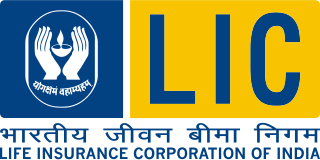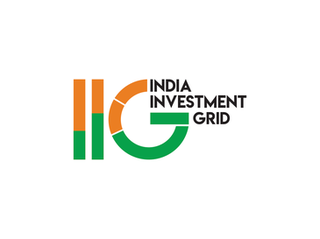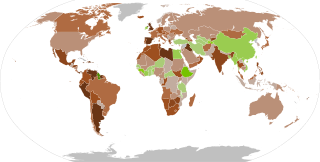The Economic Survey of India is an annual document of the Ministry of Finance, Government of India. The Department of Economic Affairs, Ministry of Finance presents the Survey in the Parliament every year, just before the Union Budget. It is prepared under the guidance of the Chief Economic Adviser of India. This document is presented to both Houses of Parliament during the Budget Session.

Life Insurance Corporation of India (LIC) is an Indian multinational public sector life insurance company headquartered in Mumbai. It is India's largest insurance company as well as the largest institutional investor with total assets under management worth ₹52.52 trillion (US$630 billion) as of March 2024. It is under the ownership of Government of India and administrative control of the Ministry of Finance.

The Union Budget of India, also referred to as the Annual Financial Statement in Article 112 of the Constitution of India. It is the annual budget of the Republic of India set by Ministry of Finance for the following financial year, with the revenues to be gathered by Department of Revenue to identify planned government spending and expected government revenue and the expenditures gathered by Department of Expenditure of the public sector, to forecast economic conditions in compliance with government policy.

Anganwadi is a type of rural child care centre in India. It was started by the Indian government in 1975 as part of the Integrated Child Development Services program to combat child hunger and malnutrition. Anganwadi in Hindi means "courtyard shelter" in English.
The 2009 Union budget of India was presented by the finance minister, Pranab Mukherjee, on 6 July 2009.

Nirmala Sitharaman is an Indian economist, politician and a senior leader of the Bharatiya Janata Party (BJP) serving as the Minister of Finance and Minister of Corporate Affairs of the Government of India since 2019. She is a member of the Rajya Sabha, the upper house of the Indian Parliament, representing Karnataka since 2016 and previously represented Andhra Pradesh from 2014 to 2016. Sitharaman previously served as the 28th Defence Minister from 2017 to 2019, thereby becoming India's second female defence minister and the second female finance minister after Indira Gandhi, and the first full-time female minister to hold each of those portfolios. She served as junior minister in the Modi ministry between 2014 and 2017, holding successive positions, first for her dual appointment as the Minister of State in the Ministry of Finance and the Minister of State in the Ministry of Corporate Affairs from May to November 2014, and then as the Minister of State for the Ministry of Commerce and Industry from May 2014 to September 2017, before being elevated to senior posts within the Union Cabinet.

The 2015 Union budget of India refers to 2015–2016 Union budget of India. The beginning of the budget printing began on 19 February 2015 with the traditional halwa ceremony. From 20 February until the presentation of budget about 100 government employees remained locked up in the North Block of the Secretariat Building, New Delhi, which houses the budget printing press, to maintain secrecy. The budget was presented on 28 February by Finance Minister Arun Jaitley.

The 2016 Railway Budget of India refers to the Railway Budget of the Indian Railways in the fiscal year 2016–17. The budget was presented by the Railway Minister Suresh Prabhu in the Parliament of India on 25 February 2016. It was the final Railway Budget of India as after this budget, the Railway Budget got merged with the Union budget of India.
Disinvestment in Public sector undertakings in India is a process of public asset sales done by the President of India on behalf of the Government of India. It can be directly offered for sale to the private sector or indirectly done through a bidding process. The Public Enterprises Survey (2015–16), brought out by the Department of Public Enterprises, Ministry of Heavy Industries, & Government of India on the performance of Central Public Sector Enterprises was placed in both the Houses of Parliament on 21 March 2017. There were 331 CPSEs in 2017-18, out of which 257 were in operation. The remaining 74 of the CPSEs were being established.
The 2017 Union Budget of India is the
The 2018 Union Budget of India was the annual financial statement (AFS), demand for grants, appropriation bill and finance bill of India for the financial year 2018–19.
Since the beginning of the Bombay stock exchange, stock markets in India, particularly the Bombay Stock Exchange and National Stock Exchange of India have seen a number of booms as well as crashes.
The 2020 Union Budget of India was presented by the Finance Minister, Nirmala Sitharaman on 1 February 2020, as her second budget. This is the second budget of Narendra Modi-led NDA government's second term. The Economic Survey for 2019–2020 was released on 31 January 2020, a day before the budget. Before the budget speech the report of the 15th Finance Commission was tabled by the Finance Minister.

The National Infrastructure Pipeline (NIP) is a group of social and economic infrastructure projects in India over a period of five years with an initial sanctioned amount of ₹102 lakh crore (equivalent to ₹120 trillion or US$1.4 trillion in 2023). The pipeline was first made public by the Prime Minister of India Narendra Modi during his 2019 Independence Day speech.

The economic impact of the COVID-19 pandemic in India has been largely disruptive. India's growth in the fourth quarter of the fiscal year 2020 went down to 3.1% according to the Ministry of Statistics. The Chief Economic Adviser to the Government of India said that this drop is mainly due to the coronavirus pandemic effect on the Indian economy. Notably, India had also been witnessing a pre-pandemic slowdown, and according to the World Bank, the current pandemic has "magnified pre-existing risks to India's economic outlook".

The Pradhan Mantri Matsya Sampada Yojana (PMMSY)(http://pmmsy.dof.gov.in/) is an initiative launched by the Government of India to establish a comprehensive framework and reduce infrastructural gaps in the fisheries sector. The scheme was announced by the Finance Minister, Nirmala Sitharaman during her speech in the parliament of India while presenting the Union budget for 2019–20 on 5 July 2019. The government intends to place India in the first place in Fish production and processing by implementing Neeli Kranti (transl. Blue Revolution). This scheme is in line with governments aim to double the farmers' income by 2022–23.
The 2022 Union Budget of India was presented by the Minister of Finance Nirmala Sitharaman on 1 February 2022, as her fourth budget. This is the third budget of Narendra Modi-led NDA government's second term. The Economic Survey for 2021–2022 was released on 31 January 2022, a day before the budget.
The 2023 Union Budget of India was presented by the Minister of Finance of India on February 1, 2023. This was the fourth budget of Narendra Modi-led NDA government's second term, starting from 2020. The Economic Survey for 2022–2023 was released on January 31, 2023 before the budget.

The New Tax Regime is a scheme of Income tax in India first proposed in Union Budget 2020–21. Subsequent Budget of FY2021-22 did not see any major announcements in this regime. During the Budget 2022–23, reports emerged that New Tax Regime was getting poor response and Government is considering to make it more attractive among the taxpayers.
The 2024 Union Budget of India was presented by Finance Minister, Nirmala Sitharaman on 23 July 2024. This was the first budget of Narendra Modi led NDA government's third term.









